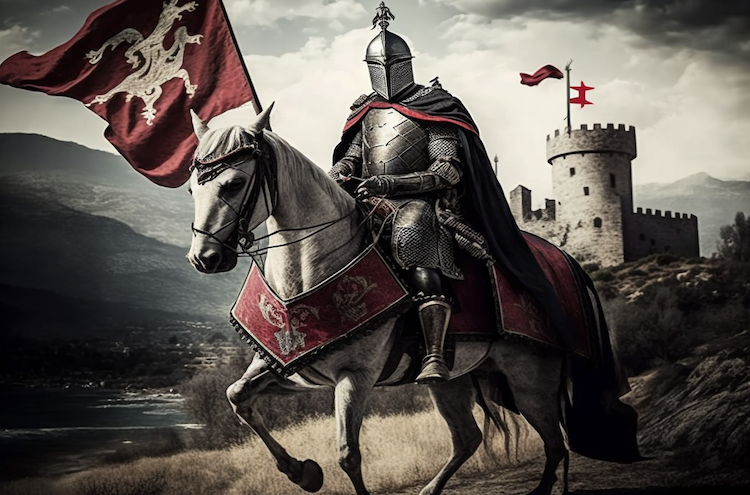
Gjergj I Balsha: Marking the Zenith of the Balsha Principality
Gjergj I Balsha (George I Balsha; r. 1372-1379) was the most important of the three heirs of Balsha I. In his stamps, attested in Ragusan documents of 1373 and 1379, Gjergj Balsha writes his name (in Cyrillic letters) as Gjorga I Balshe. The name appears in the same manner on coins of that same era. Gjergj Balsha succeeded his brother-turned-monk Strazimir I Balsha as the ruler of the Albanian Principality of the Balshas.
Marital ties of Gjergj I Balsha
In 1364, the Thopia family imprisoned Gjergj I Balsha by the Thopia after a quarrel between the two Albanian noble houses. He was released a year later with the intermediation of Ragusa. In 1367, Gjergj I Balsha conquered Budva and, soon after, Shkodra. In Shkodër, he set his capital. Two years later, in 1369, he and his two brothers were converted to Roman Catholicism by the bishop of Suacium (Shas or Svač). Also, Venetian Republic awarded him its citizenship status.

According to Eqrem bej Vlora, Gjergj was one of those remarkable figures who brought about movements of northern Albanian southwards and southern Albanian northwards. Assisted by his younger brother, Balsha II Balsha, he implemented an aggressive policy and diplomacy of intelligent marital ties.
In the early 1370s, the two Balsha brothers concluded marital ties that would soon yield significant territorial expansions. Gjergj married Olivera Mrnjavčevič, a daughter of Vukašin Mrnjavčevič (ca. 1320-1371), ruler (kral) of Western Macedonia, Kastoria (Kostur), and parts of Kosova, most notably Prizren. The said Vukašin fell in the battle of Maritza (1371), paving the way for an expansion of the Balshas into the continent.
Extending the domain
Indeed, in 1372, leveraging on the power vacuum after Vukašin, Gjergj, and Balsha II captured almost all of Kosova, from the crucial towns of Prizren and Peja into Prishtina and Artana or Kriva Reka (near Novobërdë). In 1373, Balsha extended his realm northwards, towards Konavlje, south of Dubrovnik, and Trebinje in Herzegovina. It marked the zenith of the Balsha family power. A territory that stretched from the hinterland of Dubrovnik north to Mat River south and the Adriatic deep into Kosova. It included wealthy towns such as Budua (Budva), Antivari (Bar), Ulqin (Dulcigno), Suacium (Shas), Scutari (Shkodra), Balezo (Balleza), Drivasto (Drisht), Dagno (Deja), Valona (Vlora), Kanina, Berat and Pirgo (Pirgu). The Balshas controlled all Albanian ports except for Durrës.
Gjergj II Balsha took as another wife Teodora, the widow of a certain Žarko, son of Dejan and sister of Konstantin Dejanović (ruler of eastern Macedonia). Teodora brought to the court of Balsha her son Mirkša, who would later step up, again through marriage, as Balshas governing ally in Vlorë.
Marital ties of Gjergj I’s Balsha brother, Balsha II Balsha
Vlorë, the prosperous port and fortress of southern Albania, Balshas took under their domain by marrying the youngest brother Balsha II with Komnena of Bulgaria in early 1372. Komnena was the daughter of John (Ivan) Komnenos-Asen, ruler of Vlorë, Kaninë, and the fortress of Berat from 1345 to 1363. The brother of Komnena, Alexander Komnenos Asen, governed the possession of his father until 26 September 1371 when he, like Vukašin, was killed at the battle of Maritza. Komnena remained the sole ruler of south-eastern Albania and by marrying Balsha II, offered her domains as dowry to him.

In 1372, Balsha II married Komita the Elder, daughter of the Albanian despot of Berat and south-central Albania, Andrea II Muzaka. In that same year, using the assistance of the Muzaka family, the Balshas captured the fine town of Kastoria or Kastorilia. An attempt in 1375 by Mark Kraljević Mrnjavčević, the de facto Serbian king, to recapture Kostur with Ottoman help failed. Later, as Balsha’s power in this southern area decreased, the region was governed by their Muzaka allies, Stojë and Teodor Muzaka, sons of Andrea II).
Republic of the Seas
In 1375, with the help of his brother-in-law Karl Thopia, Gjergj conquered the southern parts of Bosnia, taking Trebinje, Canali, and Trashenica. At the same time, by killing or imprisoning Vlash Matrënga (Mataranga), the Balsha annexed a significant part of the Myzeqeja plain. By now, the territories of Balshas stretched without interruption from southern Kotorr to Vlora, Himara, and Kanina. Gjergj II had just built a version of the Venetian Republic in the eastern Adriatic. When Gjergj II Balsha demised on 3 January 1379, as Eqrem bej Vlora stated, his domain stretched from Bosnia Hercegovina to Përmet and Vlora.

Bibliography
Akademia e Shkencave e Shqipërisë. Instituti i Historisë. Historia e Popullit Shqiptar, I, p. 137. Botimet Toena, 2002.
Elsie, R. (2013). A biographical Dictionary of Albanian History. p. 27. Published by I.B. Tauris & Co. Ltd. ISBN: 978 1 78076 431 3.
Directorium ad passagium faciendum (Initiative for Making the Passage). Anonymous, (1332). Retrieved from: http://www.albanianhistory.net/1332_Making-the-Passage/index.html.
Métais, S. (2006). Histori E Shqiptarëve: Nga Ilirët Deri Te Pavarësia E Kosovës. Botimet 55, Tiranë.
Muzaka, Gj. (1515). Brief Chronicle on the Descendants of our Musachi Dynasty*. Retrieved from: http://www.albanianhistory.net/1515_Musachi/index.html. *Title displayed here not as in the original manuscript.
Plasari, A. (2018). Skënderbeu – Një Histori Politike. Botimet IDK, Tiranë.
Varfi, Gj. (2000). Heraldika Shqiptare. Dituria – Tiranë.Vlora, E. B. (1956). Beiträge zur Geschichte der Türkenherrschaft in Albanien: eine historische Skizze (translated in English as: The Ruling Families of Albania in the pre-Ottoman period). Translated by Robert Elsie. Retrieved from: http://www.albanianhistory.net/1956_Vlora/index.html. Excerpt from an unfinished, incomplete, or unpublished work.







